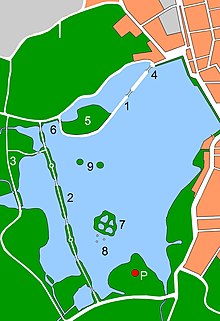West Lake
![]()
This article is about the Chinese West Lake. For other bodies of water of this name, see West Lake (disambiguation).
Template:Infobox Lake/Maintenance/NACHWEIS-SEEBREITETemplate:Infobox Lake/Maintenance/NACHWEIS-MED-TIEFE
West Lake (Chinese 西湖, pinyin Xī Hú) near the city of Hangzhou in Zhejiang is one of the largest tourist attractions in the People's Republic of China. A local name is Xīzǐ Hú (西子湖) in reference to Xīzǐ (西子), one of the Four Beauties of Antiquity. Since 2011, the cultural landscape around the West Lake has been listed as a UNESCO World Heritage Site.
The lake, 3.2 km long and 2.8 km wide, is divided by two dams. Both were named after famous poets who served as officials in Hangzhou:
Sudi (蘇堤 / 苏堤) or Su Dam, to Su Dongpo.
Baidi (白堤) or Bai Dam, after Bai Juyi.
The Chinese proverb "Up there is paradise - down here is Suzhou and Hangzhou" (上有天堂,下有蘇杭。 / 上有天堂,下有苏杭。, Shàng yǒu tiāntáng - xià yǒu Sū-Háng) also refers to the landscape around West Lake.
The West Lake has been copied in many Chinese cities. There are a total of 36 West Lakes in China and also some in Japan. The lake excites the imagination of the Chinese and is the destination of many honeymoons.
Origin
According to legend, a pearl over which a phoenix and a dragon quarreled fell to earth and formed the West Lake. In fact, the lake was formed as a lagoon of the Qiantang River, now three kilometers away. In the 8th century, during the Tang Dynasty, the lake was first excavated to its present average depth of 1.5 meters. In the following centuries, a garden landscape with artificial dams and islands was created here. Today, the West Lake is about 650 hectares in size.
Places of interest
The West Lake is divided into three parts by the short Bai Dam (shown in plan 1) and the long Su Dam (named after the Song-era poet Su Dongpo; 2). While the Su Dam was actually first constructed by Su Dongpo during his time as an official in Hangzhou, the connection of the Bai Dam and Bai Juyi is of later date. Originally, Baidi simply meant "white dam." A third ancient dam, the "Yanggong Dam" (杨公堤, "High Official Yang Dam"; 3), now runs as a road along the western shore of the lake.
The bridge from the mainland to the Bai Dam is called "Duanqiao" (断橋, "Pierced Bridge"; 4). Originally, a sluice was built there in 799 to control the water level of the lake. Later the lock was replaced by the present bridge. Crossing the Bai Dam, you reach "Gushan" (孤山, "Lonely Hill"; 5), the largest and also the only natural island of the West Lake. On its southern edge, where several buildings now stand, there was originally a palace built for the visit of Emperor Qianlong's wife. One leaves Gushan via the "Xiling Bridge" (西泠橋, "Western Bridge of Fresh Breeze"; 6).
In the middle area of the lake lies the largest of the three artificial islands, "Xiao Yingzhou" (小瀛洲, Small Paradise Island; 7) with four interior ponds, teahouses and gardens. South of the island, three stone pagodas rise from the water (三潭印月, Santan Yinyue, "Three Depths Reflecting the Moon"; 8). Two tiny islands lie between Gushan and Paradise Island; the eastern one is called "Huxinting" (湖心亭, "Pavilion in the Heart of the Lake"; 9) and the western one "Ruangongdun" (阮公墩, Islet of Lord Ruan; 9).
Another attraction is the Leifeng Pagoda (雷峰塔, "Pagoda at the Thundergulf"; P) in the south of the West Lake. Built in 972-977, it collapsed in 1924 but was rebuilt in 2002. Since then it has once again become a popular tourist attraction.

Plan of the Westsee (see text)
Search within the encyclopedia